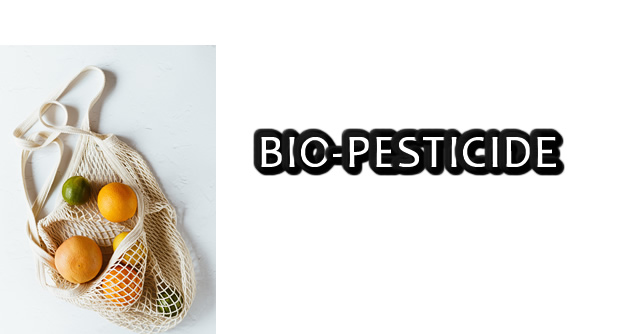In the realm of sustainable agriculture, there's a growing interest in taking pest control into our own hands. Enter the world of DIY bio-pesticides, where kitchen ingredients and garden magic converge. In this blog post, we'll not only explore the wonders of commercial bio-pesticides but also provide a hands-on guide to creating your own eco-friendly concoctions for a thriving garden.
1. DIY Neem Oil Spray: Nature's Pest Repellent
User Intent: "How to make bio-pesticides at home"
Ingredients:
- Neem oil
- Liquid soap
- Water
Method:
- Mix 1-2 tablespoons of neem oil with a few drops of liquid soap.
- Dilute the mixture in a liter of water.
- Spray the solution on plants, focusing on the undersides of leaves where pests often hide.
Benefits: Neem oil is a natural pesticide with insecticidal properties. It disrupts the feeding and reproductive patterns of pests while being safe for plants and beneficial insects.
2. DIY Garlic and Chili Pepper Spray: The Hotshot Defense
User Intent: "Homemade pest spray recipe"
Ingredients:
- Garlic cloves
- Chili peppers
- Liquid soap
- Water
Method:
- Blend a handful of garlic cloves and chili peppers.
- Mix the paste with a few drops of liquid soap.
- Dilute the mixture in a liter of water.
- Strain the solution and transfer it to a spray bottle.
Benefits: The pungent combination of garlic and chili pepper acts as a potent deterrent for a variety of pests. The soap helps the solution adhere to plant surfaces.
3. DIY Citrus Peel Spray: Zesty Pest Control
User Intent: "Using citrus peels for pest control"
Ingredients:
- Citrus peels (orange, lemon, or lime)
- Boiling water
Method:
- Collect citrus peels and place them in a heatproof container.
- Pour boiling water over the peels.
- Allow the mixture to steep overnight.
- Strain the liquid and transfer it to a spray bottle.
Benefits: Citrus oils in the peels have insect-repelling properties, making this spray effective against aphids, ants, and other common pests.
4. DIY Soap Spray: Simple yet Effective
User Intent: "Making insecticidal soap at home"
Ingredients:
- Liquid soap
- Water
Method:
- Mix 1-2 tablespoons of liquid soap with a liter of water.
- Stir gently to avoid creating excessive foam.
- Transfer the solution to a spray bottle.
Benefits: Insecticidal soap works by suffocating soft-bodied insects like aphids and mites. It's a mild yet effective solution for pest control.
5. DIY Companion Planting: Nature's Pest Management
User Intent: "Using companion plants for pest control"
Examples:
- Marigolds for nematode control
- Basil for repelling mosquitoes and flies
- Nasturtiums for deterring aphids
Method:
- Integrate companion plants strategically in your garden.
- Use them to create natural barriers or plant them alongside vulnerable crops.
Benefits: Companion planting harnesses the natural pest-repelling properties of certain plants, promoting biodiversity and reducing the need for external interventions.
Conclusion: Empowering Your Green Haven
As we wrap up our exploration, remember that the magic of bio-pesticides isn't confined to store-bought solutions. By concocting your own pest-fighting brews, you not only protect your garden but also actively contribute to the ethos of sustainable and eco-conscious gardening. So, put on your gardening gloves and let the alchemy begin – your green haven awaits, nurtured by the power of DIY bio-pesticides.
Page Links
- Exchange Rate Determination: Factors That Influence Currency Value
- Training for Speed: Expert Tips to Improve Your Sprinting Performance
- SMART Fitness Goals: The Key to Staying Motivated and Reaching Your Fitness Potential
- Fitness Tracking Devices: Do You Really Need a Smartwatch?
- Enhance Your Training with Wearable Fitness Tech: Track, Improve, Achieve
- AML Compliance -Banks : Rules and Future Practices Worldwide
- KYC: Using Blockchain for Identity Verification
- HomeBuyer's Guide to Understanding Mortgages and Rental Options in the US
- PWAs vs. Native Apps: Better Performance, Cost, and User Experience?
- The Future of Driving: Top Electric Vehicles to Watch now and Beyond
- Your Guide to Identity Theft: What You Need to Know to Stay Safe
- Deep Fakes: What They Are and Why They Matter
- Why Fortnite Is Still a Gaming Powerhouse Now
- Early Retirement Made Simple: Key Tips to Retire Early and Live Your Dream Life
- Is Buying Gold a Smart Investment? Benefits, Risks, and Trends for 2024
- Why Compounding is the Ultimate Secret to Building Wealth Over Time
- Differences in How the Rich and Poor Manage Money
- Unlock Better Health: The Crucial Role of Sleep and Tips for Improving Rest
- Why a 2% Investment Return Isn't Enough: Strategies for Achieving Real Financial Growth
- Can AI Ever Match Human Intuition and Accuracy?
- How to Lose Fat and Gain Muscle with Body Recomposition
- Simply Growing and Caring for Air Plants with Benefits
- Money Transfer Operators (MTOs) and Inward Remittance Dynamics in 2 Minutes
- Understanding Layer 2 Blockchain Solutions
- Why You Should Consider Franchising
- Ethereum ETF Approval: A Game-Changer for Investors in finance?
- Lithium Mining: Meeting The Demands For a Greener World
